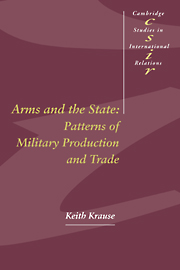Book contents
- Frontmatter
- Contents
- List of figures
- List of tables
- Acknowledgements
- Introduction
- 1 Motive forces in the evolution of the arms transfer and production system
- 2 The emergence of a global arms transfer and production system
- 3 From the Military Revolution to the Industrial Revolution
- 4 An overview of the post-1945 global arms transfer system
- 5 The dominance of first-tier producers and suppliers
- 6 Second-tier producers and suppliers: the struggle to keep pace
- 7 Dependent production and exports in the third tier
- 8 The subordinate role of arms recipients
- Conclusion
- Appendix: Arms transfer data sources and problems
- Notes
- Bibliography
- Index
3 - From the Military Revolution to the Industrial Revolution
Published online by Cambridge University Press: 22 September 2009
- Frontmatter
- Contents
- List of figures
- List of tables
- Acknowledgements
- Introduction
- 1 Motive forces in the evolution of the arms transfer and production system
- 2 The emergence of a global arms transfer and production system
- 3 From the Military Revolution to the Industrial Revolution
- 4 An overview of the post-1945 global arms transfer system
- 5 The dominance of first-tier producers and suppliers
- 6 Second-tier producers and suppliers: the struggle to keep pace
- 7 Dependent production and exports in the third tier
- 8 The subordinate role of arms recipients
- Conclusion
- Appendix: Arms transfer data sources and problems
- Notes
- Bibliography
- Index
Summary
The first wave of the arms transfer and production system, which had been triggered by the introduction of the revolutionary military technologies of gunpowder, cannon and firearms in the early fifteenth century, played itself out through the imperfect process of technological diffusion in the sixteenth and seventeenth centuries. The period that followed, from roughly the late seventeenth to the early nineteenth century, was, by contrast, relatively quiescent. The high degree of state control of arms production and exports (directly or via licensing) had the effect, as the English case demonstrated, of keeping production at or near the level needed to supply domestic needs only; thus the pace of technological change was almost consciously slowed. The weapons themselves continued to spread, diffused by empire builders and traders, but the diffusion of the techniques to produce and utilise them properly was much slower. No new centres of production arose, and the structure of the system that had manifest itself by the late 1600s was not fundamentally altered.
The most important reason for the stability of the international arms transfer system between 1650 and 1850 was the relatively slow pace of technological change compared to the preceding and following periods.
- Type
- Chapter
- Information
- Arms and the StatePatterns of Military Production and Trade, pp. 54 - 80Publisher: Cambridge University PressPrint publication year: 1992



